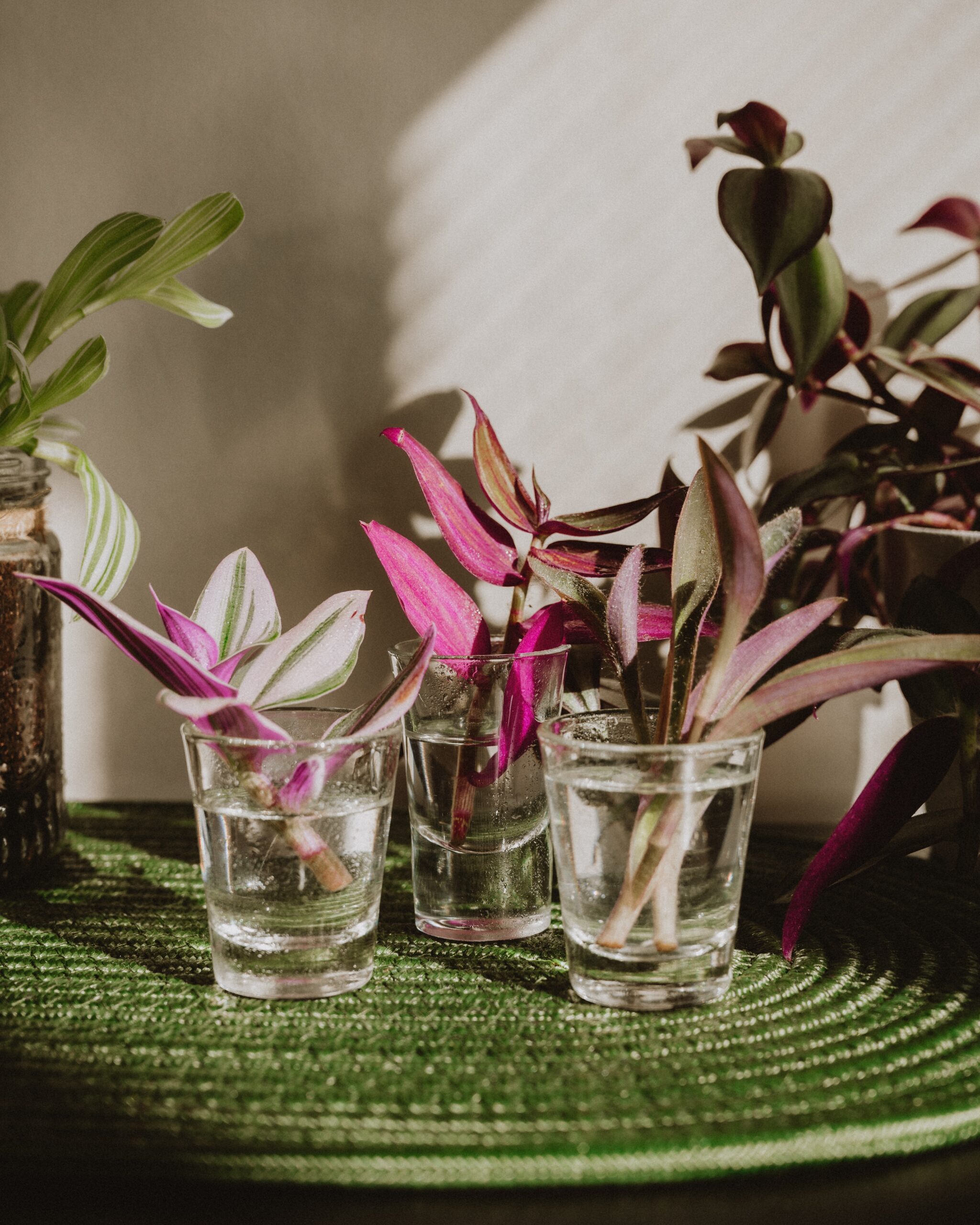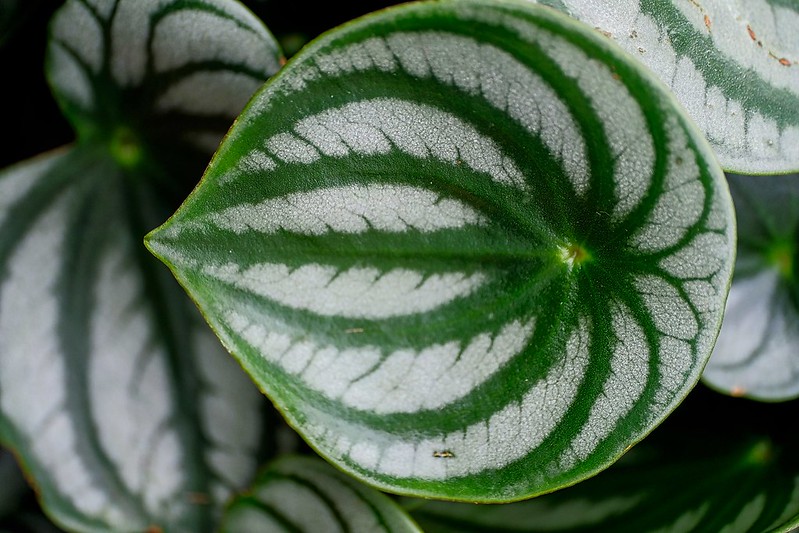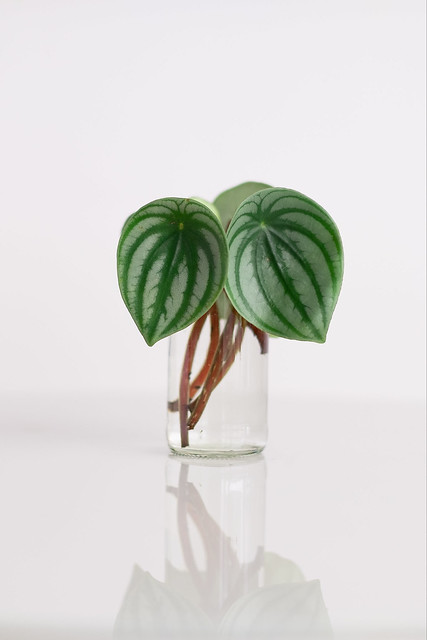The genus, Peperomia, which is very common in the hobby of growing indoor plants, is a well-loved and adored group of plants. There are several different species of Peperomia, including the ripple Peperomia, raindrop Peperomia, baby rubber plant, and many others, but today we’re focusing on Peperomia argyreia, often known as the Watermelon Peperomia plant.
RELATED: Peperomia Prostrata String of Turtles: Care, Propagation, and Watering Guide for Beginners

This well-liked species is very simple to propagate, so you can get fresh plants for nothing to keep or give away. You can take a stem cutting or a leaf in order to propagate your very own Peperomia Watermelon. Use a clean blade and a cleaned cutting surface. Use perlite, soil, water, or sphagnum moss as a propagation media. After three to four weeks, new leaves and roots will begin to appear.
Read on to learn everything you need to know about the many propagation techniques for watermelon Peperomia!
Watermelon Peperomia Overview
Watermelon peperomia, scientifically known as Peperomia argyreia, is well-known for its amazingly juicy foliage. They have beautiful green oval leaves with stunning silver stripes that resemble the skin of a watermelon. In regions of South America like Brazil and Ecuador, these cheerful residents of the jungle thrive on the forest floor.
RELATED: Spider Plant: 12 Stunning Varieties You Can Get For Your Home
Although watermelon peperomia can grow to a height of 12 inches (30 cm) in the wild, they rarely do so when cultivated indoors. Even though they may “bloom” during the growing season, all that will be visible is a few prickly shoots as opposed to budding buds.
Things To Consider Before Watermelon Peperomia Propagation
Look at your peperomia closely before you do anything, but not in a scary way. Make sure you check off these boxes before propagating your watermelon peperomia.
- It is a healthy and robust plant.
- Is already established and well-rooted.
- It is not pest infested.
Any of these problems will make it impossible for you to propagate your plant without breaking down in tears. The health and mental state of the plant are the most crucial factors while spreading it; you want to make sure both are in the positive.
How Do You Propagate Watermelon Peperomia?
You can choose whichever method works best for you when it comes to propagating Peperomia Argyreia from a variety of approaches. We’ll go into detail about how to successfully propagate these lovely Peperomias.
RELATED: How To Propagate And Care For Prayer Plants | A Comprehensive Guide

Here are the three ways you can employ to propagate watermelon Peperomia:
- Stem Cutting
- Leaf cuttings and placing them on the ground
- Growing cutlets in water
Propagating Watermelon Peperomia Using Stem Cutting
If you’re looking for rapid Peperomia watermelon propagation results, then this is the best course of action, especially if your mother plant has healthy stems from which you may take cuttings.
As a short overview, simply use some spotless, razor-sharp scissors to cut a watermelon Peperomia stem. The sprout should be “beheaded” in a way that produces a cutting with a leaf or two (for proper photosynthesis) and enough stem to keep it standing when planted in soil.
Here are the more detailed steps on propagating Watermelon Peperomia using stem cuttings:
Step 1
Before you begin, ensure that your scissors or knife have been sanitized with alcohol or by being placed in hot water. Next, grab the pot that you intend to use. It is recommended that you use the one with a drainage hole, which will remove all the excess water and prevent root rot.
The potting mix (80% soil, 20% perlite) should then be added since it improves drainage and prevents root rot.
Step 2
After making the necessary preparations, take your stem cutting—a stem of 1.2 inches (3 cm) in length—and gently insert it into the ground by digging a tiny hole in the dirt.
You can spray the cutting with a rooting hormone. The propagation process may be sped up by doing this, although it is not really necessary.
It is not suggested that you plant the stem cuttings directly in the ground because there’s a potential the plant pups won’t survive to reach the surface.
Create a 0.20-0.40-inch (0.57-1 cm) wide horizontal hole, insert the cutting horizontally or slightly diagonally, cover it entirely with soil, and allow the leaf to rest on the pot’s rim.
The pups will be able to emerge from the ground more easily in this manner.
Step 3
Mist the potting mix with water to make it moist, and do this periodically to keep the soil from becoming very dry. The damp surroundings will promote growth. Just watch out not to drown your cutting in water, otherwise, it will rot.
Step 4
Position your cutting in direct, bright sunlight and ensure that it doesn’t get colder than 50 degrees Fahrenheit (10 degrees Celsius). It may take one to three months before you notice any pups.
Propagating Watermelon Peperomia Using Cut Leaves
Peperomia has a particularly remarkable feature in that many species may be propagated using leaves. Even a small piece of a leaf might sprout several new plants. Only a few species of houseplants, including the well-known Begonia, exhibit this.

Here is the list of things you will need to employ this method:
- Healthy leaf
- Sanitary, well-cut scissors or a knife
- Container soil (or any other soil suitable for this type of plants)
- A pot or a box
- A plastic bag (or a clear glass container you can place over the pot)
- Water (rainwater or tap water that you had in a jar overnight)
So, how do you go through this method? As a short overview, you may cut just the leaf from the main plant, whatever you like, and incorporate as little or as much of the stem as you wish. The leaf could even be sliced in half or four-quarters. A small piece of stem can be helpful if you want to propagate in water, but anything will work in soil.
For more detailed instructions, continue reading below:
Step 1
Prepare a container by draining excess water, adding the potting mix, and cutting a leaf with a sterilized knife or pair of scissors.
Since this form of propagation doesn’t require it, the length of the stem is irrelevant in this situation.
Step 2
This method of propagation is quite helpful if a leaf dropped off or the stem of your cutting broke. However, it is the leaf that is the most important plant part of this method. A leaf must be cut throughout the width, right through the veins, while being held vertically.
Step 3
Dig a hole in the ground and set the leaf in it, veins facing the ground. The roots will spread out from the veins.
You can dip the stem in root medium to promote growth before that, but it’s not required.
Step 4
To create a homemade greenhouse that will retain the moisture inside, you can also wrap the pot in plastic wrap. To prevent mold growth in your soil, remove the plastic every day.
Keep in mind that if you bury it too deeply, your offspring won’t make it to the light and will perish.
Alternatively, you may let it develop in water; however, more on that later, or you can utilize the opposite half of the leaf with the stem in the same manner. Baby plants will begin to grow in about a month or two.
Propagating Watermelon Peperomia in Water
It is worth mentioning that growing your watermelon Peperomia in water is really not necessary. It’s only sometimes worthwhile to go through a water stage because these guys root so well in the soil! If you’re employing leaf fragments, water propagation is also not the best solution because they could easily become submerged and decompose.

Even so, because it’s so aesthetically pleasing, many houseplant aficionados still like watermelon Peperomia growth in a lovely vase or glass. The following are some options you have if you have a stem cutting or a leaf cutting with a stem:
Step 1
Find a vase or glass that is suitable. Peperomia cuttings frequently develop plantlets that might be harmed if you attempt to remove them from a slender vase, so stay away from ones with a very thin neck.
Step 2
Place the cutting in the container once it has been filled with clean water so that the stem is about halfway buried.
Step 3
Place everything in a warm, bright area that is shielded from direct sunlight. Algae growth and water overheating are both effects of too much sun.
Step 4
Be patient and keep the water fresh. During the summer, the first roots and plantlets may begin to emerge in a week or two, but it may take considerably longer during the chilly and dark winter.
Step 5
No need to be concerned about any plantlets developing underwater; they can manage this for the time being just fine.
How To Pot Your New Watermelon Peperomia Plants
You can transfer your brand-new watermelon Peperomias to pots once there is robust root growth on your cuttings and plantlets have a few leaves apiece. However, unless the plantlets are already large enough to effectively support themselves, it is best to opt not to split them at this stage.

Plant the baby plant in the soil and make sure that the baby leaf and plantlets are not covered, but the root system is. To prevent it from toppling over while it settles, you might need to support the plant at first using a stick.
At first, the whole thing could appear a little limp while the roots adjust to the soil. Simply maintain a very slight moisture in the medium, and make sure there is enough of light. When the first traces of new growth start to appear, you know you’re safe!
Frequently Asked Questions
How should a Peperomia Watermelon mother leaf be used after being propagated?
The mother leaf won’t need to be taken out because it will naturally wither away. Of course, you are free to do it if you so like, but take care not to harm the roots.
Why does the cutting from my Peperomia Watermelon keep decaying in the water?
Too many germs in the water is one of the causes of a Peperomia Watermelon cutting dying. Fill up your jar with new water after cleaning it with vinegar. Every two days should be enough time to change your water, but don’t forget to save some for later.
How simple are watermelon peperomias to maintain?
Although they are tropical plants, watermelon peperomia don’t require much upkeep. They can be left to their own devices very nicely without getting out of hand as long as they receive the proper amount of water.
Due to their small size, watermelon peperomia make excellent desk or bookshelf plants. However, you might ask, is watermelon peperomia toxic? The quick answer is no. They are not harmful, therefore, they do not endanger children or pets.
How frequently should I water my peperomia watermelon?
Use a simple finger dip test to determine whether the top inch or two of their soil is dry to prevent a parched peperomia. Once the water begins to leak out of their nursery pot, give them a nice swig. To avoid overwatering, make sure there are lots plant drainage holes.
Insufficient watering will result in drooping foliage, while excessive watering will cause rotting roots.
How much lighting is required for my watermelon peperomia?
Under the cover of the forest, the wild watermelon peperomia enjoy a nice balance of sunlight and shade. You may recreate these conditions at home by putting them in a location that receives moderate light.
If your peperomia is receiving too much sun, you will notice that its beautiful stripes are beginning to fade. Additionally, this may begin to scorch their gorgeous foliage. The leaves will turn a darker shade of green and lose their variegation if not exposed to enough light.
Final Thoughts
Watermelon peperomia are one of the most popular species of peperomia and an excellent tropical plant for beginners. They respond wonderfully to relatively straightforward maintenance requirements, providing you with a minor yet exquisite splash of color.
The Watermelon Peperomia has so many excellent qualities, including gorgeous appearance, ease of maintenance, friendliness toward children and dogs, and ridiculously simple propagation. This one is ideal for passing along to your friends for all the previously listed reasons.
Watch the video below to learn more about Watermelon Peperomia propagation:
Propagate yours now and spread the love brought by watermelon peperomias!
We hope you learned something from this article, here are other articles that you can learn from:
Alocasia Dragon Scale: Your Must-Have Care, Propagation, and Watering Guide
Philodendron Rojo Congo: The Best Care, Propagation, and Watering Guide You Need
Philodendron Birkin: Its Most Informative Care, Propagation, and Watering Guide







